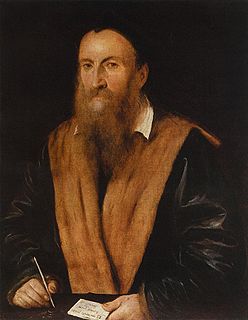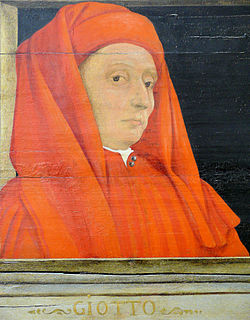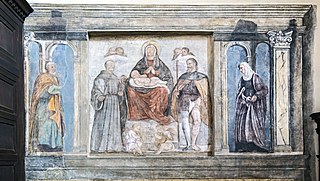Related Research Articles

Padua is a city and comune in Veneto, northern Italy. Padua is on the river Bacchiglione, west of Venice. It is the capital of the province of Padua. It is also the economic and communications hub of the area. Padua's population is 214,000. The city is sometimes included, with Venice and Treviso, in the Padua-Treviso-Venice Metropolitan Area (PATREVE) which has a population of around 2,600,000.

Altichiero da Verona, also called Aldighieri da Zevio, was an Italian painter of the Gothic style.
Pier Antonio Mezzastris was an Italian painter of the Quattrocento, painting in a somewhat provincial style for the time.

Girolamo Romani (Romanino) was an Italian High Renaissance painter active in the Veneto and Lombardy, near Brescia. His long career brought forth several different styles.

Jacopino del Conte (1510–1598) was an Italian Mannerist painter, active in both Rome and Florence.

Giusto de' Menabuoi was an Italian painter of the early Renaissance. He was born in Florence.
The decade of the 1450s in art involved many significant events, especially in sculpture.

Pompeo Ghitti was an Italian painter of the Baroque period, active mainly in and in towns surrounding Brescia.

The Church of the Eremitani, or Church of the Hermits, is a former-Augustinian, 13th-century Gothic-style church in Padua, region of the Veneto, Italy. It is also now notable for being adjacent to the Cappella Scrovegni with Giotto frescoes and the municipal archeology and art gallery: the Musei Civici agli Eremitani, which is housed in the former Augustinian monastery located to the left of the entrance.
Girolamo Santo was an Italian painter of the Renaissance, active in the 16th century. In Padua, he painted the facade of the Cornaro Palace, several frescoes in S. Francesco, and, with Bernardo Parentino, scenes from the life of St. Benedict in S. Giustina. A curious picture of a genealogical tree in the Santo is also ascribed to him. He was still living in 1546.

Giotto di Bondone, known mononymously as Giotto and Latinised as Giottus, was an Italian painter and architect from Florence during the Late Middle Ages. He worked during the Gothic/Proto-Renaissance period. Giotto's contemporary, the banker and chronicler Giovanni Villani, wrote that Giotto was "the most sovereign master of painting in his time, who drew all his figures and their postures according to nature" and of his publicly recognized "talent and excellence". Giorgio Vasari described Giotto as making a decisive break with the prevalent Byzantine style and as initiating "the great art of painting as we know it today, introducing the technique of drawing accurately from life, which had been neglected for more than two hundred years".

Stefano da Ferrara was an Italian painter from Ferrara who active in the latter half of the 15th century.

Francesco Alberi was an Italian Neoclassical style painter, active in Bologna, Padua, Rimini and Rome.

Giovanni De Min was an Italian painter and engraver, active in a Neoclassic style.

Girolamo Tessari, also called Gerolamo Tessari or Girolamo dal Santo, was an Italian painter, active in a Renaissance style in his native city of Padua.
Giovanni Nicolò Miretto was an Italian painter active in Padua, region of the Veneto.

Jacopo da Montagnana, also known as Jacopo Parisato was an Italian painter of the early Renaissance who was mainly active in the Padua area.
The Diocesan museum of Padua displays arts and artifacts belonging to the Roman Catholic Diocese of Padua; it is housed in the 15th-century former bishop's residence or Palazzo Vescovile. The building, adjacent to the Cathedral of Padua, faces the Piazza del Duomo, can in the historic center of Padua, region of Veneto, Italy.
The Master of Staffolo was an anonymous late-Gothic style painter active in the region of Marche and Umbria.

Padua’s fourteenth-century fresco cycles is a UNESCO World Heritage Site in Padua, Italy, listed in 2021.
References
- ↑ Da Bellini a Tintoretto, by Alessandro Ballarin, Davide Banzato, Civic Museum of Padua (1991), page 91.
- ↑ Museo Diocesano Padova.